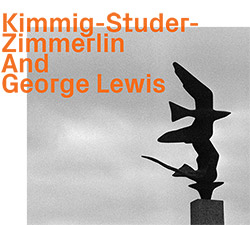
Kimmig-Studer-Zimmerlin is an improvising string trio (Kimmig, violin; Studer, double bass; Zimmerlin, cello) whose language flows out of the Western classical tradition and, to the extent one can judge from what's heard here, what one might call the post-serialist segment of that tradition rather than, say, the post-Cageian one, which is to imply a certain amount of hyperactivity and thorniness as opposed to concerns for space and silence. This kind of horror vacui stance has its fans and detractors and as, in general, one of the latter, I was intrigued to hear how/if the integration of George Lewis (trombone, live electronics) would ameliorate the situation. Lewis himself, like AACM veterans from Muhal Richard Abrams to Roscoe Mitchell and others when broaching that hazy jazz/Western classical divide, often takes a quasi-similar route, at least in recent years (his early involvement with musicians around the New York Kitchen nexus often seemed to lead to other concerns). Still, one could hope.
From this listener's perspective, the results are mixed. The first of five tracks, 'Very Nice', launches directly into the kind of robust, skittering and jam-packed improvisation that has clear links to the European improv tradition of the past 55 or so years. Unlike, say, AMM re: jazz tropes, the musicians in the trio don't attempt to discard the basic language they've learned (that of modern "classical" music), instead choosing to adapt it to the present situation. The sonic gestures are recognizable, the crests and valleys as well. Lewis sometimes joins the fray, sometimes seeks to undergird it with subtle, more riparian tones (both on horn and via electronics) making for a mix that often works quite well, especially in the softer portions, but at other times feels uncertain. 'Seven Colors and Number Ten' is much more generally successful, Lewis' thin electronics, including some samples of what sounds like conversation, setting the stage for delicate and sensitive work from the trio, arco, pizzicato and making small sounds on the instrument bodies. It gradually achieves greater density and activity but sounds natural, not forced, on its way to that state. 'Night Walk' is thick, claustrophobic and assaultive, quite intense and effective as far as it goes, though one has little sense of the musicians listening to each other on more than a superficial level, no particularly incisive commentary or offering of counter-strategies. Even so, the concluding several minutes migrate to a much more thoughtful terrain. A similar arc occurs in the closing track, 'Tactus and Tatum'.
Overall, hit and miss depending on the direction from which you're approaching. Expertly played all around and Lewis, as ever, is a pleasure to hear in and of himself. Just more for the rough and tumble, busy as a bee listener than the more contemplative one.
Comments and Feedback:



More Recent Reviews, Articles, and Interviews @ The Squid's Ear...


|

